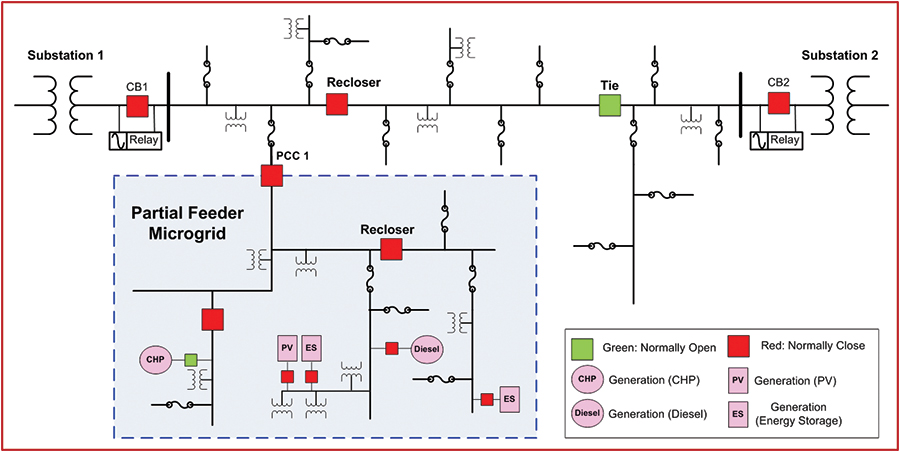Many electric utility companies are actively developing microgrid projects that will be integrated within the existing utility distribution system. The challenges and opportunities associated with a utility integrated microgrid will vary from utility to utility and site to site. Each utility site will have many unique attributes (e.g. system characteristics, customer mix), and variables (e.g. number of customers, generation types and sizes) that need to be carefully considered and properly evaluated as part of the project planning and design stage. The first step in the conceptual design process is to consider the objectives and goals for the microgrid. Although this is a critical first step in the design of any microgrid, the focus of the article will be on the challenges and benefits with integration of a microgrid within the larger existing distribution network.
Existing Electrical Configuration
Each utility distribution system has its own unique topography. The PECO Energy distribution system can be characterized as a mature metropolitan area network that evolved over many years. The evolution of this network has been driven by population and load growth in the Philadelphia area and technology changes over the years. As a result, many areas within the distribution network were overlaid with additional circuits of increasing voltage that reflect the load growth and technology changes. While this topography provides customers with increased reliability and resiliency advantages, it presents challenges for the implementation of a microgrid.
PECO partnered with Quanta Technology in 2015, to help advance multiple conceptual pilot designs that had been developed. An iterative process was utilized to evaluate, enhance, and develop each pilot into a high performance conceptual design. Feasibility and business case studies were developed for each pilot that identified benefits, performance, costs, optimal design configuration, and operating capabilities. PECO microgrid designs are focused on maintaining service to critical and public service providers during storms and other events that can cause lengthy grid power outages. These types of public service providers can support surrounding area customers with the critical services they need during long term grid outage events. To accomplish this goal, PECO decided on incorporating parts of existing feeders in a microgrid system boundary and design partial feeder microgrids, as defined in figure 1. Partial feeder designs are focused on maintaining service to a small geographic area that is fed from a larger feeder. The initial review of the existing distribution system electrical configuration in these areas quickly revealed that there were multiple circuits and voltages feeding these areas. This fact more closely reflects reality for many mature utility companies in established metropolitan areas and highlights the additional levels of complexity for partial feeder design in these areas. In contrast to building a microgrid in a green field, it was discovered that, in order to include the desired public service customers in a microgrid system boundary, there were varying amounts of electrical reconfiguration work required for each proposed area. The varying amounts of complexity and cost have a large impact on cost and feasibility of a project, which may result in multiple design iterations to further re-evaluate customer mix and microgrid size to manage cost versus expected value propositions.

Figure 1 – A typical microgrid developed on part of a distribution feeder
supplied from two different substations (partial feeder microgrid)
(click to enlarge)
As previously mentioned, one of PECO Energy’s primary goals is to increase resiliency in areas that have reliability challenges associated with large storm events. It is not a surprise to find out that these areas are typically supplied by aerial distribution facilities that are more susceptible to wind and ice storm events. While partial microgrid designs mitigate damage associated with the loss of utility supply between the substation and the microgrid, they will not be successful if there are existing aerial facilities within the microgrid footprint itself. Each project that was evaluated had some combination of aerial and underground facilities within the microgrid footprint. As a result, various amounts of aerial hardening work were identified to ensure that the microgrid would continue to operate in extreme weather situations, when it is needed most.
Reliability Considerations, Analysis, and Benefits
A significant effort was made by PECO and Quanta to evaluate and analyze existing reliability performance within each proposed microgrid footprint. Historical reliability data was collected for each microgrid footprint. Reliability performance drivers, such as cause and fault location, were analyzed to determine how much impact the microgrid would have on reliability improvement. Future reliability performance was estimated based on the learnings from this analysis to determine the benefits that could be achieved with the microgrid. As expected, the greatest benefit was in the area of minimizing outage duration (CAIDI). While there was some improvement in reducing the number of interruptions (SAIFI), this benefit is variable and dependent on the design and operating capabilities of the microgrid. This is primarily due to the fact that most on site generation would normally be off at the time of a grid interruption and would require some amount of time to start up and perform the load restoration process. Microgrids with simple load restoration schemes and battery storage will have higher SAIFI improvements than ones that do not.
Technology Integration and Interoperability Challenges
To achieve coordinated control and operation of the distributed energy resources and loads within a microgrid, various technologies and assets within the microgrid boundary need to exchange measurement data, information (setpoints and status signals), and commands among each other, or between end devices and a central control system. In a microgrid, real time monitoring, control and protection is the key technological enabler in supporting the autonomous operation and overcoming the technical challenges.
Some of the key technical challenges for utility microgrids include: transition between island and parallel modes of operation, protective relay and distribution system operation coordination, managing voltages and reactive power requirements on branches with bidirectional power flows, as well as fault detection and protection within the microgrid footprint. New control and protection schemes that are suggested as potential solutions to the above technical challenges are all requiring a reliable and fast communications infrastructure with focus on interoperability as the core function. Without interoperability, integration of the technologies and schemes becomes the most burdensome aspect of microgrid deployment and will add unmanageable risk in sustaining an island.
Enhancing the electrical distribution system with Microgrids
There are many options and benefits associated with microgrids. Some of the key benefits include: enhancing resiliency and reliability of the grid, leveraging the utilization of renewable resources, and facilitating the participation in ancillary service market, to name a few. However, there are many benefits that will enhance the overall operation of the larger utility macrogrid. Utility companies are best positioned to understand, coordinate, and control microgrids and other types of distributed energy resources to enhance and maximize the benefits for all customers. Potential utility applications include: targeted load relief, additional reliability contingency support, system voltage and frequency support, and deploying microgrid in areas that have load constraints and growing electrical demands. To leverage these capabilities and benefits, utilities will need to incorporate microgrid control within their existing distribution operations centers and integrate this control with their distribution management systems.
Closing Remarks
There are many challenges and opportunities for utility integrated microgrids. This article touches on a few of the technical and operational challenges associated with the development of a utility integrated microgrid project. Although, there are many utility connected microgrids in existence today, most have a limited capability to enhance and complement the macrogrid. As utility integrated microgrids proliferate, it is expected that the industry will focus on more mature use cases and benefits and develop a better understanding on how microgrids can benefit all customers in a utility service area.
About the Authors
 Eric Stein is a Principle Engineer at PECO Energy with over 34 years of experience in generation and electric and gas distribution systems. He has a Bachelors degree in mechanical engineering from Villanova University and has Masters degree in engineering and organizational dynamics from Widener University and the University of Pennsylvania. Eric also served in the US Navy as Hull Maintenance Technician.
Eric Stein is a Principle Engineer at PECO Energy with over 34 years of experience in generation and electric and gas distribution systems. He has a Bachelors degree in mechanical engineering from Villanova University and has Masters degree in engineering and organizational dynamics from Widener University and the University of Pennsylvania. Eric also served in the US Navy as Hull Maintenance Technician.
 Farid Katiraei, Ph.D. is senior director of Renewable Integration and Microgrids for Quanta Technology. He has more than 15 years of professional experience in the areas of distributed generation interconnection, power electronics and modeling and analysis of system transients and dynamics. In the recent years, Farid has been the technical leads for design, development and testing of several pilot projects for utilities in North America involving renewable technologies, advanced distribution automation, energy storage and microgrids. Farid has received his PhD from university of Toronto in 2005. He is a Senior Member of IEEE, Steering committee chair of the international microgrid symposium, and active participants in several technical working groups and standards development task forces within IEEE, IEC and CIGRE.
Farid Katiraei, Ph.D. is senior director of Renewable Integration and Microgrids for Quanta Technology. He has more than 15 years of professional experience in the areas of distributed generation interconnection, power electronics and modeling and analysis of system transients and dynamics. In the recent years, Farid has been the technical leads for design, development and testing of several pilot projects for utilities in North America involving renewable technologies, advanced distribution automation, energy storage and microgrids. Farid has received his PhD from university of Toronto in 2005. He is a Senior Member of IEEE, Steering committee chair of the international microgrid symposium, and active participants in several technical working groups and standards development task forces within IEEE, IEC and CIGRE.







